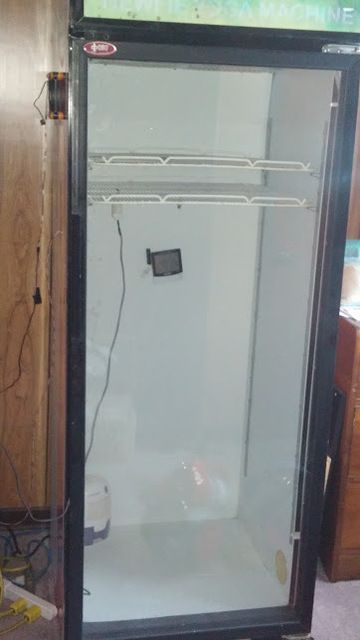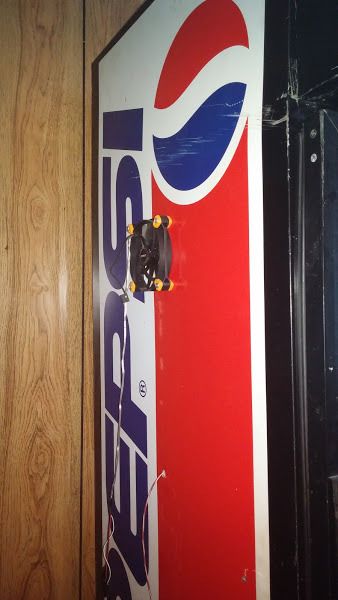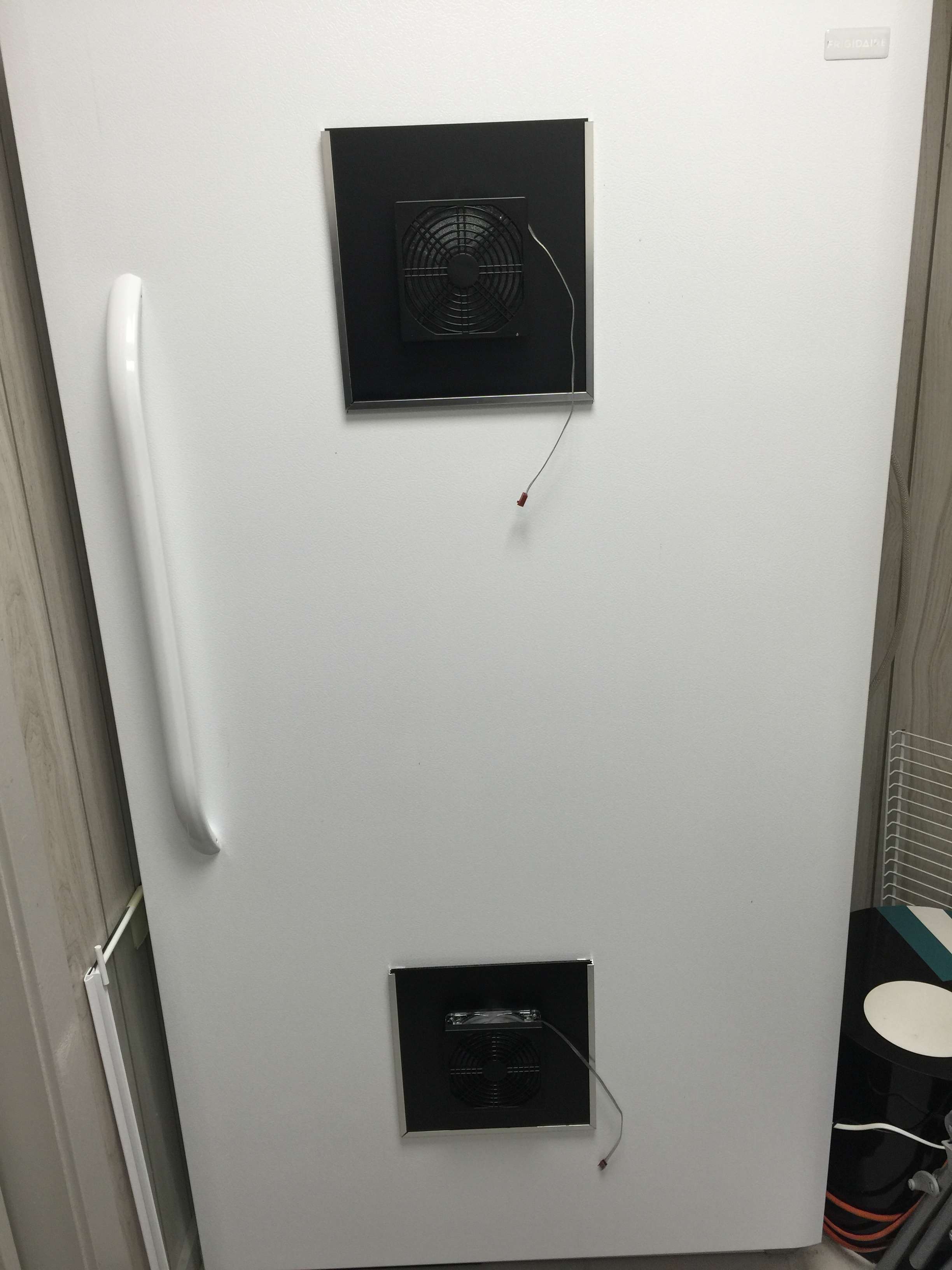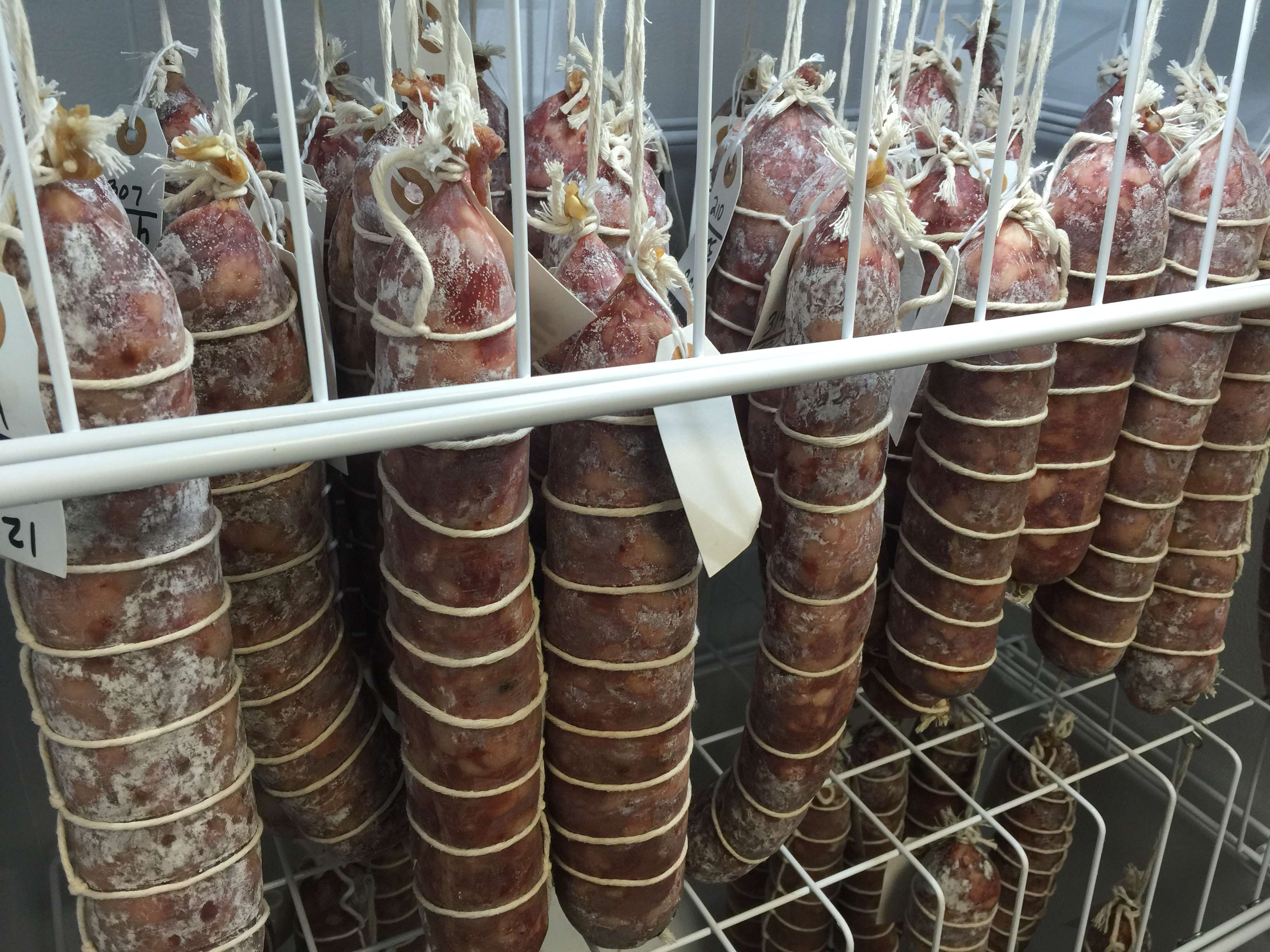Italian sausage questions
-
LOUSANTELLO
- Forum Enthusiast

- Posts: 573
- Joined: Fri Dec 18, 2015 23:35
- Location: Chicago
Lou doing it that way you cant control how long or how often the air exchange fan will run, as it will be tied to the humidifier. If you run it on a separate timer (they are inexpensive) you can independently control the air exchange on a set cycle.LOUSANTELLO wrote:On the lower section, I'm going to create a panel with a variable speed computer fan tied into the humidity "on" circuit. This will run the fan and vent the unit during the humidity cycle.
Also note that depending on the ambient temperature and humidity the air exchange will either raise or lower the humidity level, just like opening the door.
-
LOUSANTELLO
- Forum Enthusiast

- Posts: 573
- Joined: Fri Dec 18, 2015 23:35
- Location: Chicago
-
harleykids
- Passionate

- Posts: 310
- Joined: Fri Jan 08, 2016 03:03
- Location: Olathe, KS
I have to humbly disagree. With a chamber as small as a fridge, the air will be exhaustep many times over with a bottom exhaust fan.
Having the intake on the top, with a top exiting humidifier, causes a circular airflow pattern within the chamber. Intake on the bottom with a top exiting humidifier does not.
My chamber works perfectly, only pure white.mold and never had an issue with stale air.
Plus, pulling air from down low is asking for trouble with dirt, dust etc.
Intake up high, exhaust down low for a fridge setup.
That's what I suggest based on the size of a fridge/freezer chamber.
It's the size of the chamber that negates the humidity principle.
Having the intake on the top, with a top exiting humidifier, causes a circular airflow pattern within the chamber. Intake on the bottom with a top exiting humidifier does not.
My chamber works perfectly, only pure white.mold and never had an issue with stale air.
Plus, pulling air from down low is asking for trouble with dirt, dust etc.
Intake up high, exhaust down low for a fridge setup.
That's what I suggest based on the size of a fridge/freezer chamber.
It's the size of the chamber that negates the humidity principle.
-
LOUSANTELLO
- Forum Enthusiast

- Posts: 573
- Joined: Fri Dec 18, 2015 23:35
- Location: Chicago
The definition "intake" is vague and the definition "exhaust" is also vague. Let's all assume we all agree the exhaust is on the bottom. Based on that, there are 3 options: Please voice your opinion. A= fan on top pulling air IN and vent hole on bottom. B= Vent hole on top and fan on bottom pulling air OUT. C= Fan on top pulling air IN and Fan on bottom pulling air OUT (2 fans).
There are some digital ones that will do that, but 3 or 4 times a day for 10 or 15 minutes is all you need for air exchange.LOUSANTELLO wrote:Who makes a 24 event timer to turn this on for 5 minutes every hour?
That's what filters are forharleykids wrote: Plus, pulling air from down low is asking for trouble with dirt, dust etc.
Please explain what you meanharleykids wrote:It's the size of the chamber that negates the humidity principle.
Not that I can say which way is better but my big curing chamber that I have not used in months but when I did had a 4 inch vent hole on the bottom covered with breathable cloth for a filter and a 4 inch hole on top with a two speed fan to exhaust the air when the small Eva-Dry dehumidifier came on. I found the fan only needed to run on low to do its job. I ran this setup with many pounds of meat going through it and never had a issue. I think you guys are worried to much about science and not making product 






My rationale for drawing the air in at the bottom and forcing it out at the top, is that as the air becomes humidified it rises to the top, making it more of a natural air flow when it exhausts. But this may not be the right way to go in every situation. I suppose that if the the fan creates enough velocity it should be able to exhaust from anywhere in the chamber. I currently vent my chamber anywhere from 2 to 4 times in a 24hr. period for 30 minutes at a time since that is all my cheap (and very dependable) analog timer can handle. But I do have an order for a digital timer capable of 8 cycles per day and once it arrives, for starters I will be running it for 5 minutes every 3 hours. http://www.amazon.com/Comforday-Program ... imer&psc=1harleykids wrote:I have to humbly disagree. With a chamber as small as a fridge, the air will be exhaustep many times over with a bottom exhaust fan.
Having the intake on the top, with a top exiting humidifier, causes a circular airflow pattern within the chamber. Intake on the bottom with a top exiting humidifier does not.
My chamber works perfectly, only pure white.mold and never had an issue with stale air.
Plus, pulling air from down low is asking for trouble with dirt, dust etc.
Intake up high, exhaust down low for a fridge setup.
That's what I suggest based on the size of a fridge/freezer chamber.
It's the size of the chamber that negates the humidity principle.
It seems that the large majority of guys who have built curing chambers take the air in at the bottom and vent it out at the top. But this also becomes more complicated if we take the stack effect into consideration. What that means is that warm air rises and cool air falls. So if the ambient air is warmer than your curing chamber, it just might be better to take air in at the top. But then it depends on the difference in pressure as well. So as Devo says, there is a bit of science to it, and as a guy educated in the humanities, I'm not qualified to conduct any credible analysis in this area. All I can do is read the instructions and follow.
To achieve the desired water activity in the sausage it is necessary to
control the drying of the sausage in a slow and steady way, which is a difficult
task. There is a delicate equilibrium between two physical processes, water
diffusion from inside the sausage to the outer surface and evaporation from the
outer surface to the environment. Both processes, diffusion and evaporation,
must proceed at similar rates to have the correct drying (Fig. 4.
them are related to the characteristics of the sausage itself, with pH and case
diameter being the most important. But other factors, of great importance, are
related to the chamber environment. So, if the relative humidity in the chamber
is decreased too fast, there is a rapid drying that results in case hardening, an
excessive dry and hard outer layer, slowed water diffusion and, consequently,
evaporation.
To solve this equilibrium, there is a practical rule that consists of keeping
the relative humidity in the chamber about 5-10% lower than the water activity
value (expressed as a percentage) of the sausage (Lucke 1985). In general, the
temperature during this stage is mild, around 12-16C, and the relative humidity
is decreased in a progressive way (RH from 90 to 65%). Some air velocity
(around 0.05-0.1 d s ) is recommended to homogenize the humidity in the
chamber environment. In general, the starting fat content and case diameter have
increased sausage percent yields (Palumbo et al. 1976a). The casing must stay
attached to the mixture when the sausage shrinks during drying. In addition to
drying, there are important chemical and biochemical changes that are
responsible for sensory properties.
Since I am planning to build a new chamber at some point this year, I have been making notes from what others have done with their chambers. Here is what Evan Brady wrote on the subject of air velocity:
...in commercial salumerias the air velocity is generally 0.05-0.1 m/s (meters per second). Now, previously when I worked at a salumeria in California we used a Travaglini system that vented stale air in the chamber every 30 minutes, and introduced fresh air. So, to simulate this on a budget I bought a 110cfm computer fan (which is = 0.062 m/s (well within the range from Toldra)) and attached two of them in the main chamber to circulate and homogenize the air. Both of them are attached to a 24 hour, 8 phase (programs) timer that will only power the fans for 1 hour every 2 hours. I am currently constructing a venting systems as well. I am going to drill a hole in the side of the chamber then attach another fan with another 24 hour timer to blow the stale air out while another fan at the same time pulls new air into the chamber at the 2 hour mark for 5 minutes before the other timer kicks on the two internal fans to homogenize the new air in. So 4 fans total, 2 internal to homogenize, and 2 to blow and pull new air in. Both on independent 24 hour 8 phase (programmable) timers.
To learn about the dynamics of a curing chamber, including air velocity and direction, I really encourage you guys to read Chapter 5 in Fidel Toldra, ed. Handbook of Fermented Meat and Poultry You can dowload the book here and have enough reading material to last you for the rest of the winter.
http://www.academia.edu/8548143/handboo ... nd_poultry
Last edited by redzed on Tue Jan 26, 2016 18:59, edited 1 time in total.
-
harleykids
- Passionate

- Posts: 310
- Joined: Fri Jan 08, 2016 03:03
- Location: Olathe, KS
Very good info!
I can tell you that I have learned a lot by having a real time, live video feed from inside my chamber. I can watch the humidifier come on, and see just how quickly the area fills with humidity, which only take about about 5 seconds. I can also see the airflow pattern inside the chamber, just like watching the contrail on a bullet fired from a rifle on a humid day (ex-military here) like we did in long range weapons school.
I was very surprised to see just how quickly the entire chamber is engulfed in humidity, and how the small exhaust fan pulled the top exiting humidity down thru the entire area.
I run a pretty common tear drop style ultrasonic humidifier and on about 60% output setting it simply cranks out the humidity. I am guessing that is why most fridge size curing chambers work so well. They are rather small areas compared to their humidification source. Easy to flood the area with humidity, and then keep that humidity in the ideal range for quite some time, while quickly exhausting and then replenishing that same area with fresh air.
I'm sure a large walk in chamber would take a much more substantial humidifier...if it looked anything like mine then you would immediately be enveloped in a dense fog with very limited visibility! Like having a four foot tall humidifier putting out a foot wide stream of fog instantly.
The $69 DLink wireless camera was one of the best purchases I have made.
If anyone is interested in the non-scientific visual of the inside of my chamber, I can post a few screen captures of the chamber in all its glory..
I can tell you that I have learned a lot by having a real time, live video feed from inside my chamber. I can watch the humidifier come on, and see just how quickly the area fills with humidity, which only take about about 5 seconds. I can also see the airflow pattern inside the chamber, just like watching the contrail on a bullet fired from a rifle on a humid day (ex-military here) like we did in long range weapons school.
I was very surprised to see just how quickly the entire chamber is engulfed in humidity, and how the small exhaust fan pulled the top exiting humidity down thru the entire area.
I run a pretty common tear drop style ultrasonic humidifier and on about 60% output setting it simply cranks out the humidity. I am guessing that is why most fridge size curing chambers work so well. They are rather small areas compared to their humidification source. Easy to flood the area with humidity, and then keep that humidity in the ideal range for quite some time, while quickly exhausting and then replenishing that same area with fresh air.
I'm sure a large walk in chamber would take a much more substantial humidifier...if it looked anything like mine then you would immediately be enveloped in a dense fog with very limited visibility! Like having a four foot tall humidifier putting out a foot wide stream of fog instantly.
The $69 DLink wireless camera was one of the best purchases I have made.
If anyone is interested in the non-scientific visual of the inside of my chamber, I can post a few screen captures of the chamber in all its glory..
-
harleykids
- Passionate

- Posts: 310
- Joined: Fri Jan 08, 2016 03:03
- Location: Olathe, KS
-
LOUSANTELLO
- Forum Enthusiast

- Posts: 573
- Joined: Fri Dec 18, 2015 23:35
- Location: Chicago
-
LOUSANTELLO
- Forum Enthusiast

- Posts: 573
- Joined: Fri Dec 18, 2015 23:35
- Location: Chicago
-
harleykids
- Passionate

- Posts: 310
- Joined: Fri Jan 08, 2016 03:03
- Location: Olathe, KS
Added a new post http://wedlinydomowe.pl/en/viewtopic.ph ... 93fc8c9c8d with some screen shots from the live video feed inside the chamber when the humidifier comes on.
Hope it helps the folks on the forum.
Hope it helps the folks on the forum.
Last edited by harleykids on Mon Jan 25, 2016 05:19, edited 1 time in total.




